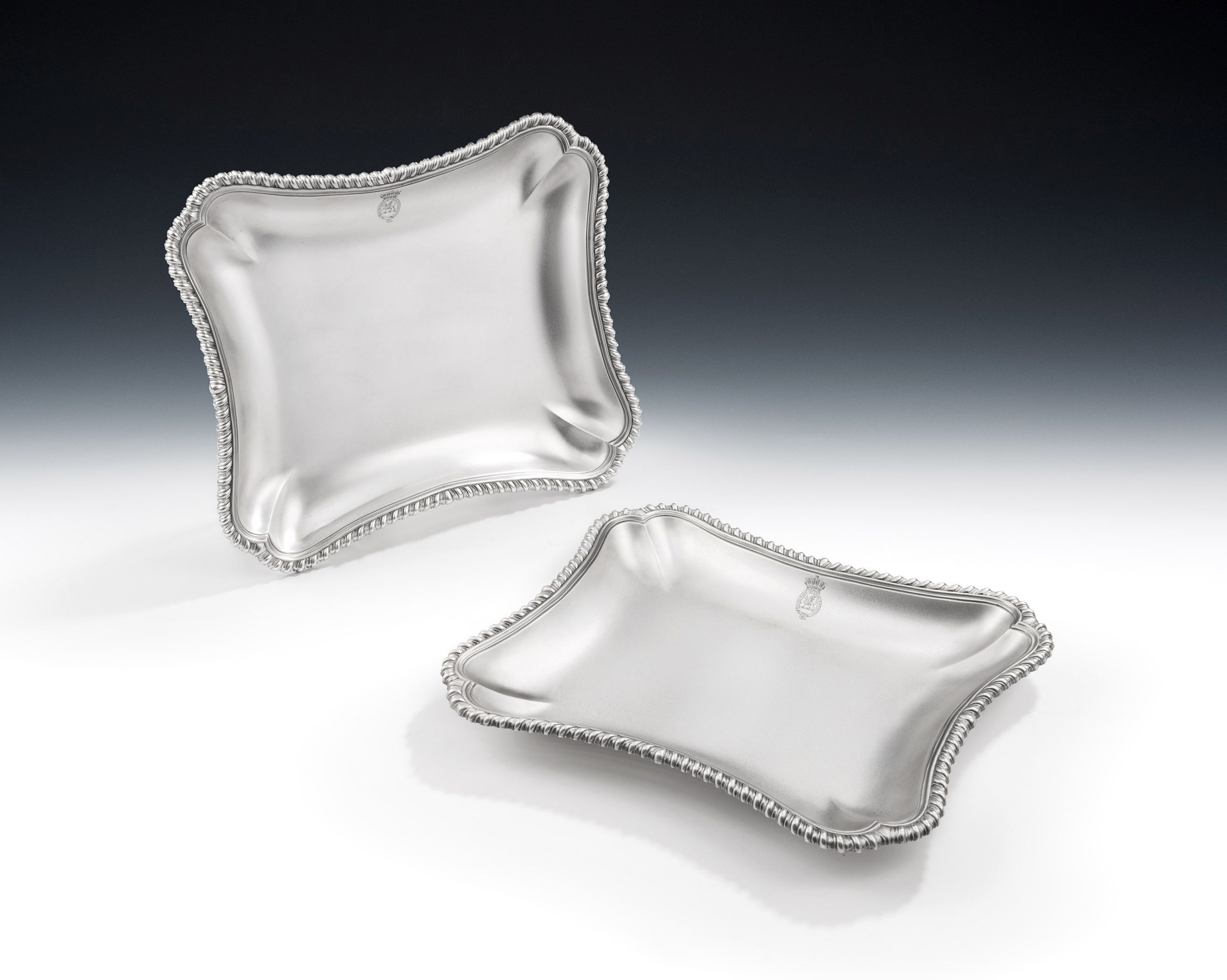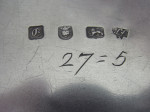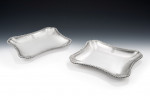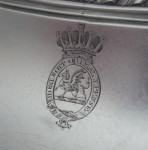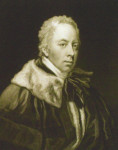Frederick Kandler. A very fine pair of early George III Cushion Shaped Vegeatble Dishes made in London in 1762 by Frederick Kandler.
Frederick Kandler. A very fine pair of early George III Cushion Shaped Vegeatble Dishes made in London in 1762 by Frederick Kandler.
375446
The Dishes are modelled in a very attractive cushion shape with raised rim decorated with gadrooning. The border is engraved with a Crest surrounded by the Motto of the Order of the Garter, all surmounted by the Coronet of an Earl. The Dishes are well marked on the reverse and are engraved with their original scratch weights. Both pieces are of an excellent weight and are in exceptional condition, having seen little use and wear. These heraldic bearings would have been engraved in 1807 to show that the 1st Earl had been made a Garter Knight, a very prestigious accolade.
The Crest and Coronet are those of Sir William Lowther, 2nd Baronet and 1st Earl of Lonsdale, created 1807. In the same year he was created a Garter Knight, hence the Motto of the Order of the Garter, surrounding the Crest, which was the personal gift of the Monarch. He was born in 1757, M.P. for Carlisle 1780-1784, Cumberland and latterly, for the county of Rutland. Lieutenant Colonel in 1800, Lord Lieutenant of Cumberland and Westmorland 1802-44. In 1781 he married Augusta, daughter of the 9th Earl of Westmorland. He died in 1844. An image of the 1st Earl is shown and also his seat, the magnificent Lowther Castle in Cumbria.
The Earl was an exceedingly wealthy man, both from the size of his vast estates and the huge production of coal on some of them. Some accounts state that he was the richest Peer in the country. He certainly liked his silver and, unlike even the Prince Regent, he had no fewer than four complete silver dinner services, one for each of his principal residences. A number of cushion shaped dishes by Kandler were sold in the great Lonsdale Sales of February, 1947 at Christie’s.
Length: 10.1 inches & Width: 8.5 inches.
Weight: 54.1 oz – a very good weight.
CHARLES FREDERICK KANDLER
The identity of this highly important maker remains a baffling mystery. His name is obviously German, and it would seem reasonable to think, from his ability to create such different flamboyant quality shapes in so much of his work, that there is a connection with the Meissen porcelain modeller with the same name. The late Norman Penzer, when working on the subject of the great wine cooler in the Hermitage, made considerable effort to uncover any clue to his origin without success. His first dated marks, (sterling and new standard), are entered as a large worker in partnership with James Murray, 29th August 1727. Address: ‘in Sant Martens Lein’, which appears to be in Murray’s hand after his signature rather than in Kandler’s. There is a third, new standard, apparently entered at some time, undated, for Kandler alone without address. In this the mitre above the initials appears, which is not in the Kandler/Murray marks, and a similar unregistered sterling mark CK with mitre above is found on the remarkable undated kettle in the Victoria & Albert Museum. The third mark provides an important link by being re-struck in the same entry as the fourth and fifth marks, 10th September 1735. These have been considered by Penzer and others to be that of a separate individual as the name is entered in Benjamin Pyne’s hand, (The touch Warden of the day), as ‘Charles Frederick Kandler in German Street near St James Church’, and he so signs in full, the first and last names being clearly in the same hand as those of the first two entries. This entry may have been made on Kandler’s move to Jermyn Street, since it not only has the new standard mark KA, but also the fifth mark using the initials FK for the first time. This is followed by a sixth entry, 25th June 1739, in which the signature, allowing for age and the dropping of Charles, is clearly the same hand again. The last and seventh mark is a variant of the sixth entered below the 1739 mark and only countersigned by the Warden Joseph Howard, as usual. The discovery of a further new standard mark in 1964 on a magnificent inkstand of 1751, in company with much other family plate bearing the earlier established marks, was an interesting addition to documented marks. The distinction of the varying Christian names is repeated in the entries of various apprentices to Kandler in the indexes to the apprentices of Great Britain extracted from the Inland Revenue books at the Public Records Office. Charles Kandler, goldsmith of St James’s, Westminster, is listed as master in 1735 of Ralph Wilberforce and James Rigby. In 1743 Charles Frederick Kandler, also goldsmith, St James’s, Westminster is listed as master of William Moody. Again, Frederick Kandler of St James’s, Westminster, silversmith, appears as master of William Reynolds in 1748 and Peter Rooney in 1760. Frederick Kandler plate worker, Jermyn Street appears in the Parliament Report list in 1773.
RELATED ITEMS

